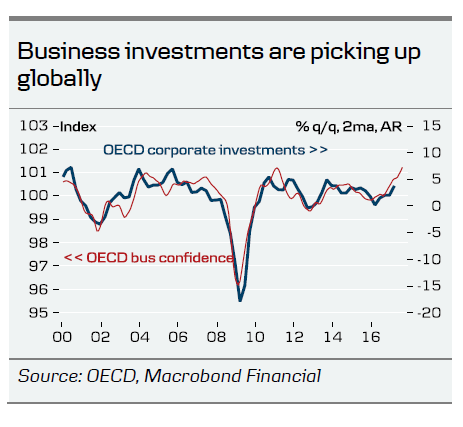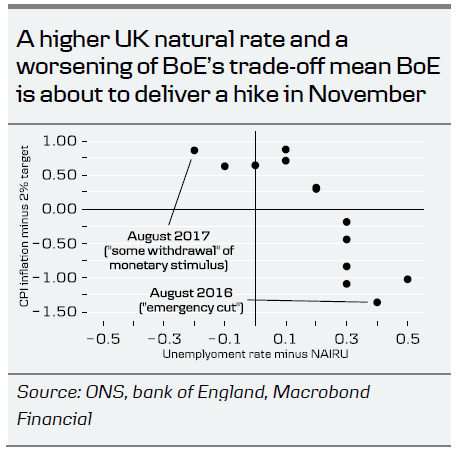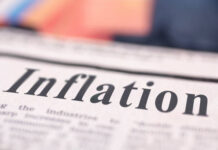Today’s key points
- While the Phillips curve theory is important to understanding monetary policy setting in the short run, the natural rate is key to understanding monetary policy setting in the long run.
- The BoE’s Mark Carney argues that structural factors continue to weigh on the natural rate but that it is increasing everywhere due to the global recovery.
- While we still expect long-term yields to increase as central banks have turned more hawkish, there is a limit to how high they can move due to the low natural rate
We have had several important central bank speeches over the past couple of weeks revealing how the major central banks are thinking at the moment. As the speeches have been quite theoretical, we have gained more information about how they see monetary policy not only in the short run but also in the long run, which may have interesting market implications – more on that later. In particular, we think Bank of England Governor Mark Carney’s speech on 18 September was quite interesting as he (among other things) touched upon the natural rate (simply put, it is the rate which should prevail in ‘equilibrium’ when the output gap is closed and growth is on trend). While the Phillips curve theory (stating that the tighter labour market will push up wages and hence inflation) is still important to understand monetary policy setting in the short run, the natural rate is key to understanding the monetary policy setting in the long run.
Carney argues that although structural factors continue to weigh down on the natural rate, it is likely increasing everywhere due to the global recovery, not least since business investments are picking up again after they declined on the back of the hard landing in China and the oil price shock beginning in 2014. Business confidence has continued higher in recent months, signalling accelerating business investment growth, see chart to the right. When looking at the economic data, it is also difficult to be very concerned, as the global economy seems in a good shape and there are not many risk factors out there at the moment – this also partly explains why we have not seen any big market corrections, as we discussed in last week’s strategy piece. Looking at some of the recent data releases: US core capex orders continued higher in August, euro area economic confidence is at its highest since the crisis and PMIs are high – all good news. The strong economic cycle and low risks mean we are still positive on equities.


If Carney is right that the natural rate is increasing, it means that a constant monetary policy is becoming more accommodative, something Carney and ECB President Mario Draghi both mentioned before the summer holiday, see also Strategy: Central banks consider leaving the party, 30 June. Theory suggests the stance of monetary policy should be measured by the so-called real policy rate gap, which is the difference between the actual real policy rate and the natural rate and not just by the current level of the nominal policy rate. If the natural rate increases and the actual real policy rate remains unchanged, the gap increases and monetary policy becomes more accommodative. This likely also explains why the Bank of England now seems on its way to delivering a November hike, in particular now that UK CPI inflation remains high and unemployment rate is below the BoE’s NAIRU estimate. One problem is, however, that the natural rate is unobservable, so we cannot know for sure.
Fed Chair Yellen also contributed to this debate during her press conference after the recent FOMC meeting and in her speech on Tuesday. Not surprisingly, she repeated she still believes in the Phillips curve and thus it is still appropriate to tighten monetary policy gradually. However, she also said that US monetary policy is close to neutral right now, (see chart below), meaning that the Fed should not hike much further, before monetary policy is neither expansionary nor contractionary. The reason why the Fed expects more than a few hikes is because Yellen also expects the natural rate is increasing, which the level of the Fed’s longer-run median ‘dot’ also shows. However, the Fed has consistently revised down its projection for the natural rate and did it once more at the recent meeting from 3% to 2.75% (in nominal terms), so the question is of course whether the Fed is once again too optimistic.
A lot of theory but what does all this mean for markets? The strong economy not only means we are positive on equities, but also that central banks are gradually turning more hawkish, which explains why we expect yields to increase, see also Yield Outlook, 15 September. However, given the natural rate will remain low even if it is increasing, there is a limit to how high yields can move and it is difficult to see the longer-end of the curve trading at the same levels as before the crisis even when monetary policy is normalised. Thus, we expect a flattening of the UST curve for the 2Y10Y on a 12M horizon, as the short end is pushed higher by Fed hikes and structural factors are weighing down on the long end. In the euro area, we expect a steeper EUR curve next year, as the ECB maintains a tight grip on the short end of the curve, while the 10Y segment of the curve is pushed higher by US yields and a market slowly pricing in an end to the QE programme/tapering in 2018. However, when the ECB begins to hike rates, perhaps some time in 2019, we may see the flattening again, as structural factors also put a cap on longterm yields in the euro area.















